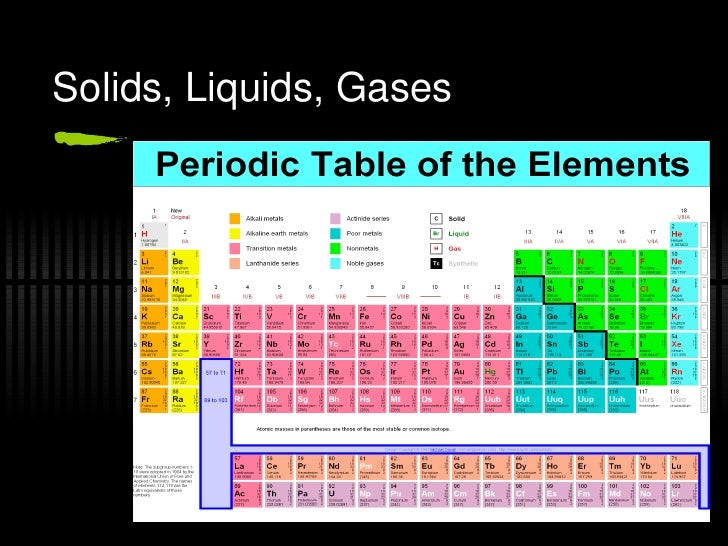

- #Periodic table simple states solid liquid gas how to
- #Periodic table simple states solid liquid gas full
Describe and model the structure of the atom in terms of the nucleus, protons, neutrons and electrons comparing mass and charge of protons neutrond and electrons. If terminology is not used correctly, children can develop or reinforce the misconception that atoms, molecules and particles are the same. Sourcing equipment for these activities can be difficult, particularly the equipment for the changes of state optional demonstrations and gas samples. Some of the ideas may be too complex for primary children to work with alone, but the particle cards could provide a simple way of grouping solids, liquids and gases under the guidance of an adult. The activity can be used as a model for whole class teaching on the differences between solids, liquids and gases and how they behave. The differences between solids, liquids and gases in terms of particle distribution.Compare and group materials together, according to whether they are solids, liquids or gases.Using appropriate scientific language and ideas to explain, evaluate and communicate their methods and findings.

#Periodic table simple states solid liquid gas how to
If you teach primary science, see the guidance below to find out how to use this resource.

Read our standard health and safety guidance.Mini whiteboards, enough for each student.Four to five samples gases – ideally two should be coloured, eg chlorine (FLAMMABLE and CORROSIVE) or bromine (TOXIC and CORROSIVE depending on concentration).Peer advocacy acts as a further stimulus to encourage learning and understanding. The activities are designed to help students order their thoughts, with discussion and questions playing a part. Purpose and criteria for successful outcomes of the work are made explicit so that students are clear about what they are doing. Act as advocate for their partner’s success.When students have completed their sheets, ask them to:.(Mini whiteboards might be used by students to sketch the particle pictures before committing these to paper.) Ask students to work individually to complete the boxes on the sheet.Agree with the students the criteria that will be used to assess their responses and explain how the assessment will be made.Give each student a copy of the ‘Gases, liquids and solids’ worksheet.Make sure there is no confusion of particle meaning grain or crystal (eg of sugar or salt) and meaning the tiniest thing of which something is made up (eg atom, molecule, ion). Which pile represents solids, which liquids and which gases.What they think ‘neatly ordered’ and ‘randomly organised’ mean.Particles not close together and randomly organised.Particles close to one another and randomly organised.Particles close to one another and neatly ordered.
#Periodic table simple states solid liquid gas full
Give each pair a full set of ’Particle cards’, and ask them to sort the cards into three heaps: Share the objectives with the students and explain that they will look at modelling to describe gases, liquids and solids, and to explain differences in their properties.Īrrange students to work in pairs.Ensure that the words gas, liquid and solid are used and understood.Invite students to describe what they see.As an option, use some demonstrations to show change of state (see ‘Examples of change of state’ sheet).Display four to five samples of a solid, four to five samples of a liquid, and four to five samples of a gas (ideally two should be coloured, eg chlorine or bromine).Sequence of activities Introduction and demonstration The difference between solids, liquids and gases can be explained using the particle model.Substances are made up of tiny particles.Explore the use of models to describe gases, liquids and solids.Reinforce their understanding of the terms gas, liquid and solid.The activity provides an opportunity for students to: They interpret diagrams on cards showing representations of particles and may observe a teacher demonstration. Students think about gases, liquids and solids in terms of the particle model. RSC Yusuf Hamied Inspirational Science Programme.Introductory maths for higher education.The physics of restoration and conservation.


 0 kommentar(er)
0 kommentar(er)
